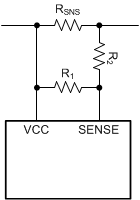SLVS503F November 2003 – February 2020 TPS2490 , TPS2491
PRODUCTION DATA.
- 1 Features
- 2 Applications
- 3 Description
- 4 Revision History
- 5 Pin Configuration and Functions
- 6 Specifications
- 7 Detailed Description
- 8 Application and Implementation
- 9 Power Supply Recommendations
- 10Layout
- 11Device and Documentation Support
- 12Mechanical, Packaging, and Orderable Information
8.2.2.1 Select RSNS and CL setting
The TPS2490 monitors the current in the external MOSFET (Q1) by measuring the voltage across the sense resistor (RS), connected from VIN to SENSE. When the voltage difference across the Vin and Sense pins (VCL) is greater than 50 mV(typical), the LM5069 will begin regulating the MOSFET gate. Size RSNS for maximum or minimum VCL for applications that require guaranteed shutoff or guaranteed conduction. In this design example, RSNS is sized to exhibit minimum VCL across RSNS at maximum load current.

Typically sense resistors are only available in discrete values. If a precise current limit is desired, a sense resistor along with a resistor divider can be used as shown in Figure 19.
 Figure 19. SENSE Resistor Divider
Figure 19. SENSE Resistor Divider If using a resistor divider, then the next larger available sense resistor should be chosen (1 mΩ for example). The ratio of R1 and R2 can then be computed as follows:

Note that the SENSE pin typically pulls 7.5 µA of current, which creates an offset across R2. TI recommends to keep R2 below 10 Ω to reduce the offset that this introduces. In addition the 1% resistors add to the current monitoring error. Finally, if the resistor divider approach is used, the user should compute the effective sense resistance (RSNS,EFF) using Equation 8 instead of RSNS in all equations.

Note that for many applications, a precise current limit may not be required. In that case, it is simpler to pick the next smaller available sense resistor. For this application, a resistive divider was not used, and a 4 mΩ resistor was used for a 12.5 A (typical) current limit.